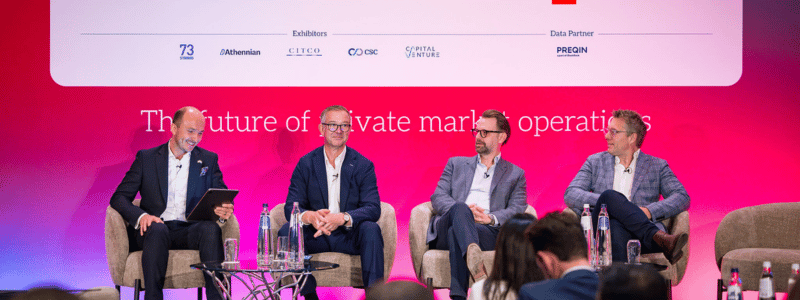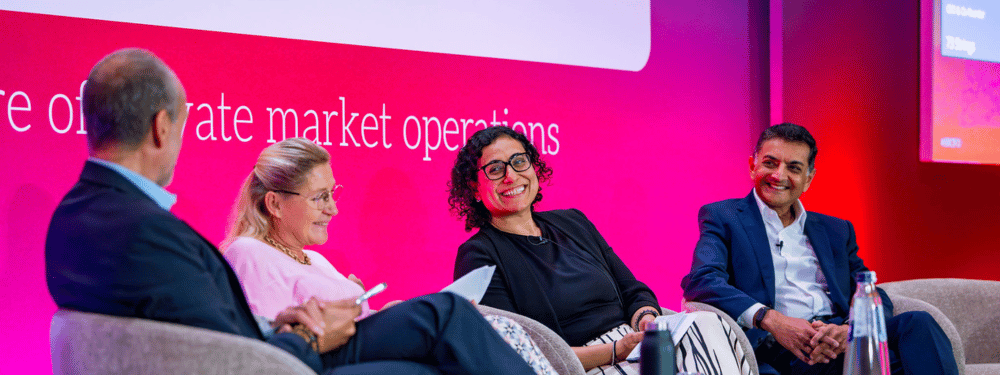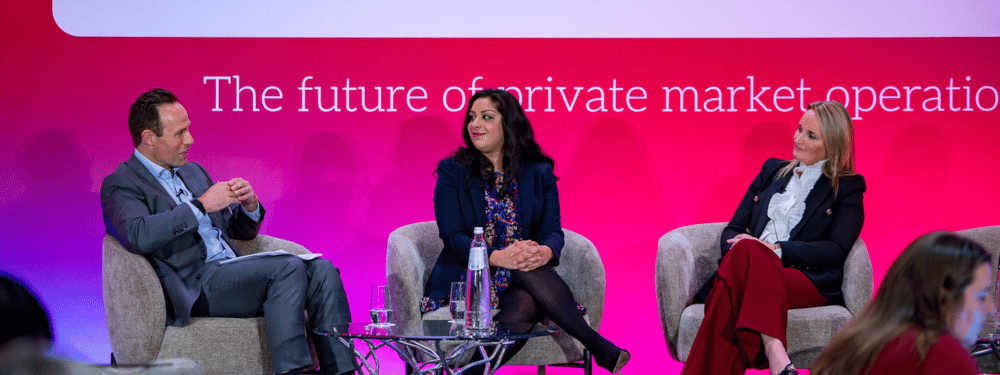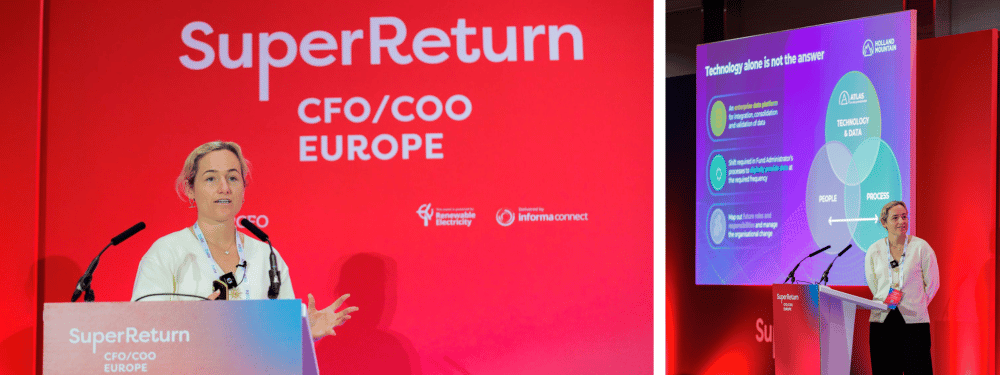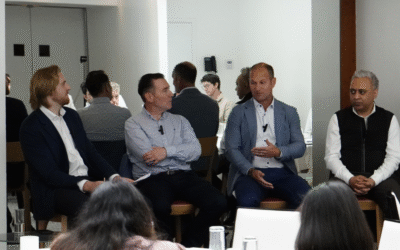Against the backdrop of a sunny Amsterdam, more than 200 private markets CFOs and COOs gathered to discuss the latest trends.
Holland Mountain sponsored the conference and captured key takeaways from panels across both conference days, as well as the dedicated summit day focused on data, technology, and AI.
Below, we’ve distilled six core themes that emerged across the sessions.
1) AI: the star of the conference
Every panel mentioned AI at least once. Adoption is clearly accelerating, but the targeted use cases, human-in-the-loop approach, and rigorous controls over models, data, and permissions are key.
- AI has evolved from chat to assistants and now agents. The biggest challenge isn’t the AI model itself, but controlling who can access what data – keeping the AI’s source material (its document collections) tightly restricted and secure.
- Many firms now use an AI gateway – a control layer that ensures only approved models are used, which makes it easier to switch providers and keeps a complete record of every interaction.
- Use AI where judgment and pattern recognition matter, like search, summarization, or spotting anomalies. Keep critical areas such as payments or cash movements fully rule-based and under strict controls.
- Firms are already seeing results: using AI to read side letters, draft DDQ responses, challenge investment theses, and support market mapping.
- At scale, especially for fund-of-funds, AI is helping firms collect, clean, and standardize large volumes of inconsistent data.
2) Operating model: scaling without increasing headcount
Scale comes from redesigning processes, clarifying who does what (in-house vs. provider), and upgrading treasury, controls, and team skills beyond Excel.
- Keep relationship-driven analytics and differentiators in-house. Outsource high-volume, standardized processing, and use co-sourcing models to avoid “black box” operations.
- Retail and semi-liquid products require tighter liquidity controls, more frequent valuations, and crystal-clear roles and responsibilities with administrators and service providers.
- Move waterfalls, portfolio aggregation, and forecasting out of Excel and into a governed software solution. Build live dashboards and visualisations into team expectations.
- CFO priorities now center on funding, financing, cost optimization, digital transformation, and vendor consolidation. Many firms are building data warehouses behind self-service LP portals to support these goals.
- Make change management a core part of transformation. Start with process redesign, appoint AI champions, create usage catalogues, deliver targeted training, and focus on quick-win pilots to overcome Excel inertia.
3) One source of truth is a priority
Durable value from tech and AI only emerges after firms standardize data, harden governance, and eliminate spreadsheet-driven shadow operations.
- Unify front/middle/back on a single data layer. Firms that do this report faster reporting cycles and better visibility across their portfolios.
- Treat administrator outputs, such as capital calls, statements, and reports, as data to be extracted and analyzed. Aim for near-perfect accuracy when converting unstructured information before applying AI.
- Replace fragile Excel models with valuations and waterfalls with controlled platforms that enforce lineage, approvals, and auditability.
- Make governance explicit. Use curated document stores with central permissions and named owners to maintain control and prevent teams from reverting to spreadsheets.
4) Hybrid stack: buy for scale, build for edge
Firms are consolidating on mature SaaS for standard workflows while building differentiated data and AI layers on top of interoperable platforms.
- Shift away from bespoke point solutions and move toward best-of-breed SaaS platforms.
- Take a mixed approach to portfolio valuations: buy and integrate tools that use external market data but build custom models for niche fund valuations.
- Standardize data schemas in a central data platform to avoid vendor lock-in and always favor open APIs, so components can be swapped without major rebuilds.
- Add light “agentic” automations on top of vendor systems to close last-mile gaps – such as generating LP reports that are 95% complete and written in the firm’s tone.
- Take a pragmatic approach: keep scopes small, start with off-the-shelf solutions, insist on vendor heavy-lifting, and work with delivery teams in your own time zone.
5) Investor experience as a growth lever
Treat every LP touchpoint as part of one system – clean data, clear ownership, and transparent portals compound into faster diligence and stronger fundraising.
- Define the full investor lifecycle – from prospecting and onboarding to servicing and re-ups – and aim for invisible excellence: accurate, timely outputs without handoff friction.
- Standardize data fields rather than templates. Break down bespoke requests into reusable data elements managed under central governance.
- Modern portals with read receipts and a clean user experience have significantly reduced late capital-call responses.
- Combine historical reporting with forward-looking metrics like cash-flow forecasting. Automate the “knowns” so people can focus on judgment.
- Ensure that best-of-breed tools work together seamlessly through APIs and eventing, allowing data to flow smoothly without re-keying.
6) What keeps you awake at night? Trust, security & regulatory readiness
Beyond the jet lag – rising cyber threats, payment fraud, and new regulations are turning security, confidentiality, and compliance into top priorities.
- Tackle emerging risks such as deepfakes and wire fraud with stronger payment controls – including lockbox architectures, tiered approvals, and out-of-band verifications.
- Strengthen cybersecurity with layered defences, robust access controls, and continuous monitoring to guard against AI-driven attacks.
- Protect confidentiality by replacing open file shares with curated, centrally permissioned stores, and limit AI tools to secure environments only.
- Prepare for more demanding regulatory expectations with clear audit trails, transparent data lineage, and firm-wide accountability for governance and oversight.
Bonus Highlight: Holland Mountain Presentation!
How to make fund admin oversight work
Holland Mountain’s Director of Business Development, Katie Brown, presented what it really takes to achieve fund administrator oversight!
Digitalizing the integration, validation, and reconciliation of data from a firm’s fund administrators can drastically enhance a fund’s operational efficiency.
However, successful fund admin oversight takes more than just technology.
Here are some of the challenges we work with firms to resolve ahead of fund admin integration:
- Teams used to shadow accounting
- Admins not using the latest tech
- Outdated SLAs and absence of defined KPIs
- Lack of a governance framework
Drawing on 15 years of experience working with Private Capital fund administrators on behalf of our clients, Katie shared how we overcome these challenges and make fund admin integration work!
Are you trying to integrate with your fund admins? We can help.
Holland Mountain works with both PE fund finance teams and their fund administrators to drive the required change to processes, operating models, and culture to achieve automated fund admin oversight.
If you are planning or trying to integrate with your fund administrators, we’d be delighted to discuss this further.

